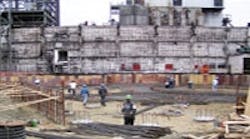Just days into his post as the Imperial Sugar Co.'s chief executive, John Sheptor was touring the company's Port Wentworth, Ga., refinery when a blast knocked him back about 100 feet to the floor. Sheptor walked away unscathed, but the explosion on Feb. 7, 2008, killed 14 workers and left 38 people injured.
More than one year after the incident, Sheptor says the refinery located near Savannah is on the road to recovery with newly implemented safety features and standards aimed at minimizing the presence of sugar dust, which two federal agencies concluded was a primary contributor to the explosion. The plant is expected to be fully operational by the fall. Among new features in the rebuilt facility is the implementation of dense-phase conveying systems rather than bucket elevators or screw conveyors to transfer product to storage.
The dense-phase systems will move sugar through a transfer pipe as a "solid bullet," leaving no room for a combustible dust cloud to form, whereas other systems have an open space that can create a combustible dust environment, Sheptor says. The U.S. Chemical Safety Board (CSB) noted in its investigation of the explosion that at least one blast occurred near a bucket elevator that lifted sugar from the refinery and carried it to storage silos. The previous five-story packaging area is being rebuilt as a two-floor structure with all the equipment on the ground floor and electrical wiring on the second-level floor to close any space above the packaging machines where dust can accumulate.
Technology Isn't Foolproof
The new systems should lessen the likelihood of a repeat incident, but technology alone isn't a panacea to process manufacturers' safety issues. In April, CSB determined that an explosion that killed two workers at a Bayer CropScience plant in August 2008 resulted from safety management lapses, possibly related in part to a lack of worker training on control systems after a maintenance shutdown.
Workers begin rebuilding silos at the Imperial Sugar Co.'s Port Wentworth, Ga., refinery where 14 workers were killed and 38 injured in a Feb. 7, 2008, explosion. After the blast, the tops of two silos storing sugar were missing, suggesting that at some point explosions occurred within the structures, according to a federal investigation.
Any time a process facility adopts new technology, plant operators should be consulted first, says Joe Scalia, a controls system architect for Invensys Process Systems. "If you're going to bring a new system into an existing manufacturing operation, the people who are the current operators and the current production people should be involved in helping define the requirements for what the new system is going to do."
Frequently, that doesn't happen, says Scalia. "So now you have a new system in and the guys who know it are your skilled tradesman and/or whatever instrumentation control techs you have and they often, as the people who should be experts, don't get nearly enough training when the system comes in the door," Scalia explains.
Food Manufacturers Struggle
Some process manufacturing sectors are further along than others in preparing employees for plantwide safety, with the food industry apparently lagging. CSB noted in a February 2008 statement on the Imperial Sugar accident that out of 281 fires and explosions related to combustible dust over a 25-year period, about 24% took place in the food industry. Scalia concurs that the food processing industry has fallen behind other manufacturers when it comes to plant safety.
"[Safety] has been less of a concern to them beyond once they got automated to process food. You can bet some of the individual equipment that came in from various OEMs came with safety protective stuff so they wouldn't hurt their skilled tradespeople or their operators, but having an overall philosophy in that plant -- highly doubtful," Scalia says.
In the sugar industry, Sheptor indicated that insufficient industrywide data impacted the plant's ability to prepare for a catastrophic event. Imperial Sugar conducted its own tests through a third-party laboratory that show the risk posed by an electric charge in the facility was greater than what was previously accepted across the industry.
The company discovered that industry literature on sugar explosivity overstated the amount of energy needed to ignite a dust cloud, Sheptor says. Imperial Sugar's tests show the energy level can be as low as a static-electricity charge, which is far below what published reports indicated, according to Sheptor. As part of the company's response to the new data, it has issued static-free clothing and footwear to workers.
Sheptor says the company, along with the rest of the sugar industry, was relying on the knowledge it had available. "The sugar industry is a relatively small industry in the U.S.," he says. "There are not a lot of producers and not a lot of sites, so there is a fair amount of movement between companies in technical personnel, so there is quite a uniformity of view with regard to the management of technology and risk in the facilities, and everyone has used a very common approach with regard to equipment selection and manufacturing processes. There are very few sugar technology programs at the universities, so again, the new professionals coming into the industry are coming from the same sources, so there's a very strong commonality of application throughout the industry."
The Occupational Safety and Health Administration (OSHA) claims that officials at the company were well-aware of hazardous conditions at the plant but took no reasonable actions to reduce the risks. The agency issued Imperial Sugar an $8.8 million fine, the third-largest in OSHA's history. Among the 108 instances of willful violations cited by OSHA is the finding that there were large accumulations of combustible sugar dust in workrooms, on electrical motors and on other equipment.
Imperial Sugar has contested all the OSHA citations. In the meantime, OSHA is in the process of issuing a comprehensive combustible dust standard.
See Also




